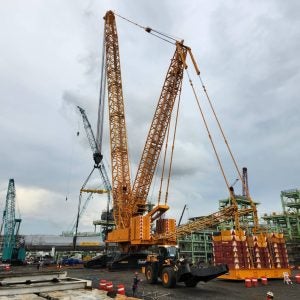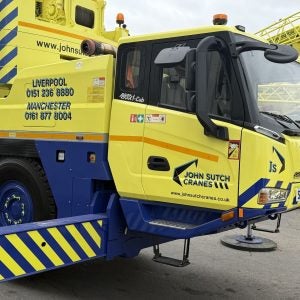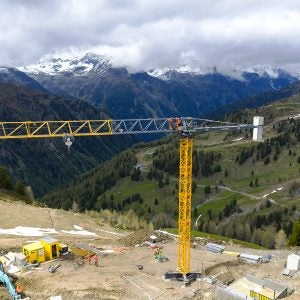Tadano Asia set up 29 days of technical training for Tiong Woon Crane & Transport (Pte), Ltd., a large, loyal customer, managing over 540 cranes with capacities ranging up to 2,000t. Among their fleet are many Tadano all terrain, rough terrain, and lattice boom crawler cranes.
Based in Singapore, Tiong Woon is a leading one-stop integrated heavy lift specialist and service provider. For over 40 years they have supported the oil and gas, petrochemical, infrastructure, and construction sectors by managing turnkey projects for EPC (engineering, procurement, and construction contractors and project owners). Tiong Woon covers projects from planning and design 2022 to the execution stage as they transport, lift, and install heavy equipment at customers’ facilities and at project sites.
Prior to training with Tadano Asia, operators had to request a site visit from the Tiong Woon service team for most problems. Despite the service team’s skills in solving issues – partially due to some receiving previous training with Tadano Demag GmbH (TDG) – they often began with little to no information from the operators. This often resulted in multiple trips that contributed to prolonged downtime.
TDG trainers gave Tiong Woon the opportunity to create a system that would allow operators to communicate more details, such as error codes, so that the Tiong Woon service team could arrive at the site better prepared.
The training was conducted at Tiong Woon’s training facility. Three representatives from the TDG led training courses: Roland Faust, Mario Rutz, and Sönke Eichhorn. Each instructor possesses anywhere from 25 to 35 years of experience in the crane industry. The 12 attendees from Tiong Woon were operators of all terrain cranes and crawler cranes joined the training.
Faust began the training in February covering the basics of AC crane models. Instruction covered CAN Bus setup and operation, understanding the electrics and hydraulic superstructure and carrier, interpreting error codes, and handling sensor calibration.
Rutz hosted four additional days of AC crane model training at the end of March into April, focusing on the AC 350-6 from basic familiarization to the steering and pneumatic systems, the hydraulic superstructure main boom, diagnosis, immobilization, IC-1 menus, and hands-on operations and troubleshooting.
Eichhorn covered the CC models over three weeks in April. He began with electrical layouts, drawings, CAN Bus training before progressing to proportional valve technology, a comprehensive look at hydraulic systems from open and closed loops, and extensive troubleshooting. From there, multiple configurations were taught using manuals and assembly drawings. Different rigging and working configurations inside the IC-1 menu were also covered before participants concluded the CC training by assembling an actual CC crane in the SH configuration.
A total of 29 days of training were provided to Tiong Woon operators of AC and CC model cranes. The attendees gained valuable knowledge in crane operations, technical troubleshooting, and maintenance work during that time, gaining a better understanding of what goes underneath the engine and how the basic electrics, hydraulics, and programming work when they are doing lifting work in the project site.
Tiong Woon representatives said that this training improved their knowledge and competency level, providing them with higher job satisfaction. They seek to build upon this by further educating its operators in partnership with senior technicians within the company.
“Tadano Asia was honoured to be able to assist in this training,” said Yoshihiro Okazaki, general manager of Tadano Asia. “It was not only simple training on how to deal with problems but also a fulfilling course from a safety perspective, such as how to prevent problems before they occur and how to avoid them if they occur. The course was very well organized from the safety point of view.”
Okazaki noted Tiong Woon’s desire to enhance the skills and competency level of their workforce, as well as to expand their recruitment efforts through such training and job re-design.
“In recent years, the shortage and aging of crane operators have become an issue in Singapore. We hope that everyone, especially the younger generations, who read this article will understand that the crane industry has evolved with continuous improvement and growth over the years. Tiong Woon has developed a well-defined career pathway for their crane operations workforce. It allows inexperienced crane operation apprentices to learn and develop as Crane Specialists, creating a new technical profession that boosts the current crane operation workforce into something valuable for all of us!”






